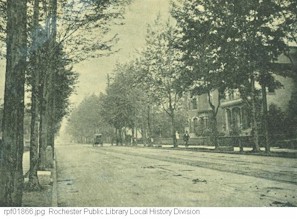
West Avenue, 1890
West Avenue: The Working Class World of Susan B. Anthony
Introduction
West Avenue (or Buffalo Street, later West Main Street), from the Erie Canal to the fork split with Chili Avenue, was affected by its proximity to the major transportation routes: canals and railroads. Industrial, commercial and residential development occurred simultaneously. This mix has persisted to the present day, although the canal was rerouted early in the 20th century, and the Buffalo, Rochester & Pittsburgh railroad station was long ago transformed into a restaurant (Nick Tahou's). Small businesses, hospitals, churches and factories existed alongside the houses of grocers, salesmen, factory workers, teachers and the most famous resident of all, the noted suffragist Susan B. Anthony.
With places to live, work, shop, learn, socialize and find spiritual and physical healing, residents had little reason to leave the neighborhood. However, with close proximity to the Erie Canal and two railroad stations, residents had excellent transportation access to the larger world if they wished to travel beyond its borders.
Today this neighborhood contains the Susan B. Anthony Preservation District, which consists of several streets of middle-class Victorian homes surrounding Susan B. Anthony Square (previously Madison Park), an Olmsted-designed park almost directly across from Miss Anthony's home.
Beginnings of the
Neighborhood
The Civil War Era
Susan B. Anthony Moves In
Residential Architecture of the Neighborhood
The Neighborhood Circa 1900
Scenes from the Neighborhood around 1900
The Neighborhood in the 20th Century
The Neighborhood Today
Send comments to Webmaster
Copyright Monroe County (NY) Library System
115 South Ave., Rochester, NY 14604